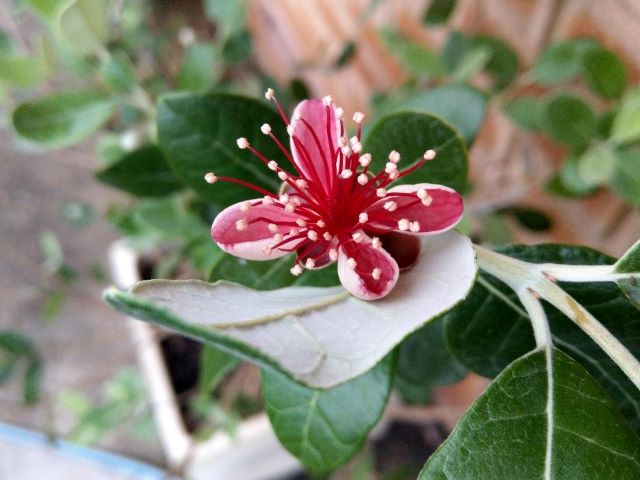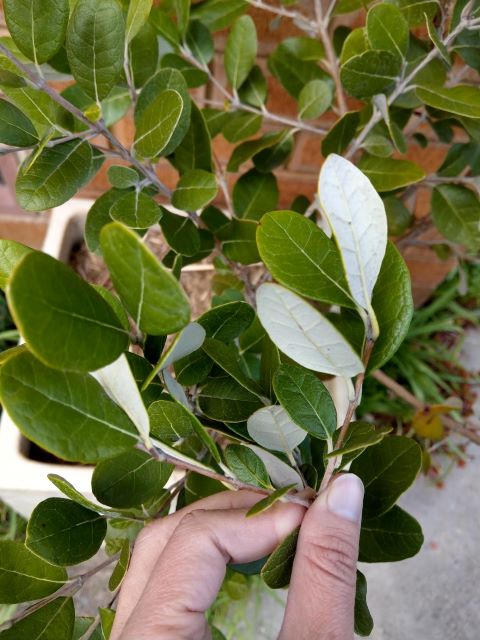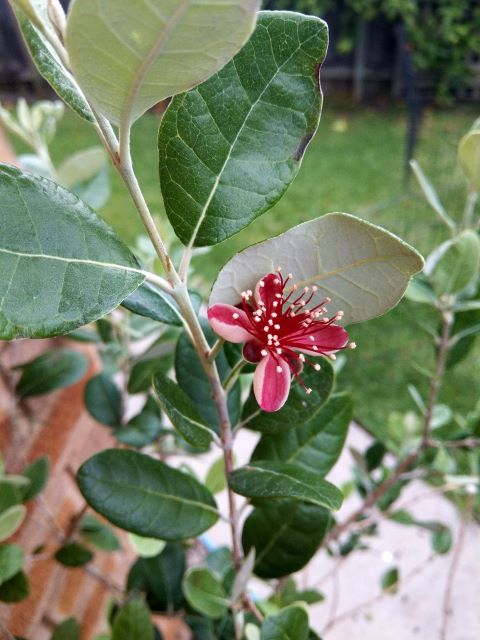Is your feijoa tree flowering but not producing any fruit? This can be frustrating because who doesn’t like cutting into a feijoa, also called pineapple guava, and scooping out the deliciousness inside? This is quite a common problem and there are measures you can take to make sure your feijoa tree produces fruit in time for the harvest.

Let’s look at the reasons why your feijoa tree is flowering, but not producing any fruit:
- The feijoa tree is too young
- Inadequate pollination
- Incorrect soil conditions
- The wrong temperature
- The feijoa tree requires pruning
- Feijoa requires fertilization
- Incorrect watering
These problems can be fixed so don’t give up so soon! Let’s have a look at each issue so you can enjoy a delicious harvest of feijoas.
Table of Contents
- The Feijoa Tree is too Young to Produce Fruit
- Inadequate Pollination Causes Feijoa Flowers But No Fruit
- Incorrect Soil Conditions Can Cause Feijoa Flowers But no Fruit
- The Wrong Temperature Can Cause Feijoa Flowers But no Fruit
- Feijoa Tree Requires Pruning
- Lack of Soil Fertilization Causes Feijoa Flowers But no Fruit
- Incorrect Watering Can Cause Feijoa Flowers But no Fruit
The Feijoa Tree is too Young to Produce Fruit

Regardless of the type of feijoa in your garden, they take a few years until they start producing fruit. Although it does depend on the climate and type of feijoa you’re growing, feijoas typically mature and begin to produce fruit when they are around 2–6 years old.
On that note, to ensure your feijoa will fruit for you, you are best off growing a variety that’s been grafted rather than grown from seed. Seed-grown feijoas are not reliable fruiters, although they do make lovely trees.
If your feijoa tree is a grafted variety but still in its first year or two, you’re likely to see flowering but no fruits.
Feijoas are pretty hardy trees so they require little care. However, it is still important that the trees establish themselves in their first few years, so make sure you’re giving them adequate care.
The fact that your feijoa is flowering is a good sign. And you should see delicious fruits when the tree matures.
Inadequate Pollination Causes Feijoa Flowers But No Fruit
A very common problem as to why your feijoa tree is flowering but not fruiting is your feijoas are not getting sufficient pollination.
Feijoa plants are self-pollinating. This means that the feijoa tree contains both male and female flowers. This enables pollen to be passed around the tree. But this doesn’t mean you should neglect this important process.
Your feijoa will thank you for having different varieties of feijoa tree planted nearby to enhance pollination through cross-pollination. It may be helpful to plant different seasonal feijoas to maximize pollination and extend the period where you can get your hands on some feijoa.
A good example is Gemini is pollinated by Apollo feijoa so pairing them together is a great idea. Otherwise, just having other varieties of feijoa will boost pollination.
Most feijoa trees can be spaced between 10 to 15 feet (3-4.5m) apart. If you have a variety of feijoa plants that can grow to be quite large, space them 20 feet (6m) apart. This will ensure that your feijoa trees don’t overcrowd each other.
If you’ve noticed that your trees is a bit too bushy, prune your plant a bit. Opening up the shrub will enable birds to come and rest on your feijoa plants. This is helpful because birds transfer the pollen.
If you can’t get the natural critters to pollinate for you as much as you’d like, try your hand at hand pollination.
There’s no fancy science to hand pollination. You grab a clean paintbrush (something with soft brushes), then gently brush flower to flower. By doing this, you act as a bee, transferring pollen from one flower to the next.
Incorrect Soil Conditions Can Cause Feijoa Flowers But no Fruit
Having damp soil that is not acidic enough is another common problem to have. This would cause poor growth, which could lead to your feijoa flowering but not producing fruit.
Your soil should be well-draining with pH levels from neutral to slightly acidic. Your feijoas will thrive in soil with pH levels of between 5.5 to 7.0. If the leaves of your feijoa tree is yellow it means your soil is too alkaline and this can compromise your fruits.
Another thing you should note is that your feijoa shrubs will not appreciate damp soil. If your soil is too damp, make sure you quickly amend the soil. There are many causes as to why your soil may be damp such as clumps, excessive soil, and so on.
This can also go the other way. For good quality feijoa fruit, make sure that you’re watering deeply. This is especially the case when your feijoa is flowering. Lack of water can cause your feijoa fruits to fall off prematurely and be dry and bitter. You’ll appreciate the quality of your feijoa fruit when you maintain your soil.
Mulching around the base of your feijoa tree with organic materials such as straws, grass clippings, and small branches is a good idea. Three important outcomes of doing this are that it stops weeds from growing and stealing nutrients. Mulching helps conserve the moisture of the soil. And mulch insulates the feijoa tree during the winter.
The Wrong Temperature Can Cause Feijoa Flowers But no Fruit

Feijoa trees do well in most climates, which is why they’re grown all over the world. However, depending on the climate in your area, there are some considerations.
Feijoas can be grown in a range of climates from cool through to subtropical. Once established, feijoas can tolerate heat and frost. And actually, feijoas cope with a large range of temperatures anywhere from 19-104 °F (-7-40 °C). Though the best conditions are where feijoas grow in cool winters with mild summers of 77-92 °F (25-33 °C).
Growing feijoas in cool climates provide the chill hours favored by them. Less than 50 hours of chill time can inhibit feijoa flower production while 100-200 chill time is ideal.
Make sure where you position your feijoa isn’t prone to strong winds. Feijoa trees don’t grow well in windy spots so if your area has chances of strong winds, think about moving your tree behind a barrier.
USDA Zones for Growing Feijoa
Feijoa tree thrive in USDA zones 8 to 11. Make sure to give them abundant sunlight for the best results. This means giving them at least 8 hours of direct sunlight every day. If you’re in zones 10 to 11 your feijoa will appreciate some afternoon shade or filtered sun during the hottest parts of the day.
Although they are very hardy plants, feijoa trees thrive in more subtropical climates with medium to low humidity. Feijoa benefits from some chill time during the coldest parts of the year and can withstand temperatures as low as 15°F (-9°C). There is a chance that if you’re in zone 8 you may get little to no fruit, depending on how cold it gets. You should reliably get fruit if you’re in zones 9 to 11.
Feijoa Tree Requires Pruning
Feijoa trees are quite hands-off trees and don’t require much maintenance. Although pruning is not strictly a requirement, your feijoas may benefit from a little bit of pruning if they are flowering but not producing any fruit.
I’ve gone over briefly how pruning opens up your tree, which allows birds to help with pollination. This is a natural source of pollination as the birds will help transfer the pollen from flower to flower.
Trimming off parts of the feijoa that appear dead or are dying is a good opportunity to trim them so that the tree can focus its energy on growing. This also encourages new growth as part of the trees’ natural defense mechanism.
Lack of Soil Fertilization Causes Feijoa Flowers But no Fruit
If your feijoa trees are flowering but not fruiting they will benefit from fertilization. Fertilizing your shrubs will support the growth and overall health of the plants.
With fertilization, timing is everything if you want to optimize the growth of your delicious feijoa. It’s good to feed your tree in late winter, very early spring, and again in early summer. To avoid stimulating growth that could be damaged by frost, you should stop fertilizing two months before the first frost date in your area.
That said, feijoa trees grow slowly so they won’t require too much feeding. The key is, once your trees have fruited and you’ve harvested your delicious feijoa, make sure to give them some fertilizer to encourage new growth and keep the momentum going.
When looking at organic fertilizers, you should look for something that contains trace elements like copper, boron, magnesium, zinc, manganese, iron, and molybdenum. I really like this organic fruit tree fertilizer.
Incorrect Watering Can Cause Feijoa Flowers But no Fruit
As briefly mentioned above, watering contributes to the quality of the soil. But watering the right amount, and making sure that the feijoa tree roots are receiving enough water is a big contributor to your feijoa trees producing fruit.
Thanks to the hardiness of the tree, feijoas are quite drought resistant. Even so, keeping them in a constant state of dehydration is not healthy for the tree. Going the other way, keeping feijoas in a state of soggy or wet soil conditions can lead to things like root rot and other harmful plant diseases.
More often than not, you shouldn’t have to water your tree every day. Of course, this would change depending on your climate.
Allowing the soil to dry out before watering your feijoa again is much better than watering a little bit every day. Again, this would be because it is better for your feijoa if you are watering it deeply, down to its roots.
If your feijoa tree has flowered, this could be a sign that it is using its reproduction defense mechanism that results in flowering due to lack of water. At this point, it may help to prune the branches of your plant by removing 3 to 4 inches to stimulate new growth.
Related Reading:
